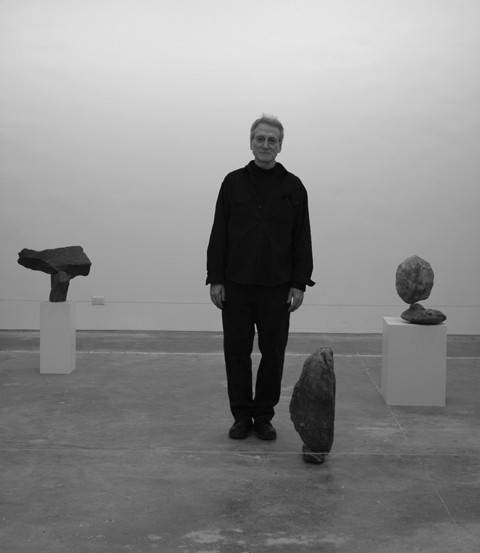A recipient of a National Endowment for the Arts fellowship in poetry in 1975, Quasha received a Guggenheim Fellowship just last year for his video project Art Is: Speaking Portraits (in the performative indicative), a series of short statements by almost 500 artists, poets, and composers (in seven countries and 17 languages), portions of which will appear in the Kingston Sculpture Biennial this summer.
Quasha’s recent work is the focus of the newly published book Axial Stones: An Art of Precarious Balance (North Atlantic Books), with a foreword by Carter Ratcliff. A selection of his recent projects will be on view in June at the Samuel Dorsky Museum of Art at SUNY New Paltz.
—Beth E. Wilson
George Quasha on his work:
Art is…
Integrity
Things are radically particular. Some things are radically new. Our education and our tendency of mind, our fear of instability, all don’t allow us to know how radically open a particular moment is, and how free we are in any given moment to let the world create itself. My one belief is that if we really could all be in that state of openness, where we honor the integrity of things, and the integrity of ourselves to start with, then we would all be where we are and we could allow the world to show us what it wants to be. We could ask, “What does Planet Earth want of us?,” instead of, “What do we want of it?” Greed and extreme wealth—to me it’s just bad thinking, it’s bad relationship, it’s bad poetics.
The poetry of dreams
Chie Hasagawa, an incredible Japanese artist—she was living with us here for 10 years. She’d been here a few years and one day she told me an incredible dream. I told her, “You’re a dreamer. Why haven’t you ever told me your dreams before?” The next day, she came and told me another one. So I said, “I’m going to write that down.” It became the first poem of the book. I said to her, “We’ve got a project here. I used to write my dreams down years ago, but this is much more interesting to me. You come tell me your dreams, and I will write them. You have to decide whether I’ve written your dream or not. Every word, everything in it, has to be your dream—no fancy poetry, no rhetoric, nothing extra. It has to be your dream, but it has to satisfy my sense of what language is.” So we had to work this compromise; it became a dialogue. We would sit for hours, sometimes into the night, and she’d say, “No that’s not it.” Or I’d get down a really great line and she’d say, “Yeah, I like that, but it’s not my dream.” Then I’d have to take it out. These are all poems that passed the test [in the book Ainu Dreams, Station Hill Press, 1999].
Inside the axial
Understanding it from the inside, the axial has to do with a certain kind of freedom of being. And bracket all those words, because it has to be open. It starts with a very physical understanding. I’ve done tai chi for years, I’ve done bodywork, and through that I’ve learned ways to move the body without forcing it, finding out what it can do. The primary understanding I’ve developed is that we are round, we’re not straight lines. We are flexible, fluid beings, and the body is always in motion. When we let that happen, that awareness starts to spread. When working with the stones, the first act was to ground this understanding in the body, getting visual cues from them, and then listening to the stones as I move them together, until a still point shows up. A still point is an alignment where this stone is completely released in alignment downward into the other stone, and it moves as though it’s weightless. That’s the still point where the axis is cleared, the axial moment. That’s very much like the moment in therapeutic bodywork when the person releases, breathing in a bigger way. If I hadn’t done it with human bodies first, I couldn’t have done it with the stones.
It’s easy to balance stones in a kind of clunky way, but if what you’re looking for is the furthest edge that they can go to, where they go beyond themselves, it’s the moment where they become something that is only possible because of this sensitive relationship that we’re all having. A willingness to be there, to let it happen. To me, that tells me a lot about what art is.
On poetics
I like to think of poetics in its original sense, which, in Greek, is simply “making.” [When I started working on my first book, America a Prophecy], a poetry anthology, back in 1973, I was interested in people who thought in language in such a way, that their language changed by the quality of the thought—there was the real poetics issue. That shows you how poetics works. Philosophy became indistinguishable from poetry at that point, and art that grew out of that perception would become a kind of poetics issue, how language and thinking extend into particular kinds of action, and have the same structure. I came into this by doing [William] Blake scholarship, and I came up with most of the methods and principles by trying to understand what Blake was doing.
I like walking into things where I don’t know anything, to just see if I can work by the principles of what my thinking is. It’s not like I know, but I’m aware that this is a possibility, so I go in there with an inquiring mind, not an “I am an authority” mind. If I go in there with an “I am an authority” mind, I would need a PhD in anthropology to teach it. If I go in with an inquiring mind, I’m just willing to ask the questions that need to be asked right now, and then I leave. It’s the Zen idea of “beginner’s mind,” keeping yourself open to the process.












